More on AMD’s XConnect Tech: Thunderbolt 3 for External Radeons
by Ryan Smith on March 10, 2016 9:00 AM EST- Posted in
- GPUs
- AMD
- Intel
- Radeon
- Thunderbolt
- Thunderbolt 3
- eGFX

Last night AMD issued a driver update that brought support for a new technology, XConnect. In a nutshell, XConnect is AMD’s trade name for running external video cards via Thunderbolt 3, a long awaited development that Thunderbolt owner Intel is finally getting behind and allowing. AMD’s driver release notes offered a handful of details, and now the official embargo for the tech is lifting, so we can fill in some of the blanks.
As our more observant readers may recall, when Intel unveiled Thunderbolt 3 back in June, they announced that they would finally be approving external video cards via Thunderbolt, and that they would be partnering with AMD to develop the initial implementation. More recently, at CES 2016 Razer unveiled the Razer Blade Stealth ultrabook, which was being immediately promoted as supporting external video cards, and was being shown off with its accompanying full power Core external video card chassis. Add the two up, and you can guess where this is going.
Today then is the formal launch of AMD’s Thunderbolt 3 video card efforts, which they are branding XConnect. The first drivers for XConnect were released last night, and now AMD is qualifying the Blade Stealth as the first laptop ready for XConnect. That said, it should be noted that while the Blade Stealth has been shipping for some time, Razer’s accompanying Core chassis has yet to ship, so anyone looking to try out XConnect will need to wait to get their hands on a Core.
Along with today’s formal unveiling of the technology, AMD is also laying out the technical requirements for supporting XConnect. Not just any laptop/desktop with Thunderbolt 3 can support an external GPU, as there are specific hardware and software requirements, which is why the Blade Stealth is the first qualified laptop. In particular, laptops need to support what is being called the Thunderbolt 3 external graphics standard, or eGFX for short. The eGFX standard in turn requires that vendors implement the necessary extensions for external graphics into their BIOS, including functionality necessary to support plug ‘n play operation. Also required is v.16 (or later) of the Thunderbolt firmware, Windows 10, and an active (not passive) Thunderbolt cable for bandwidth reasons.
With all of the necessary parts in play, from a technical perspective what we’re looking at is a somewhat more complex AMD Enduro switchable graphics setup, except with an external GPU. XConnect allows for an external video card to feed either a laptop’s internal display via the normal switchable graphics protocols, or an external monitor hooked up to the external video card. I dare say that much of this is mundane in 2016 as switchable graphics have been with us for some number of years now. What is novel here, as Intel told us as far back as June, is that what really changed their tune was that there is finally a sensible GPU hotplugging solution in place, allowing video cards to be added and removed without rebooting. This makes it much easier to use an eGFX solution – hence AMD’s focus on plug ‘n play functionality – and it means the operating system won’t crash and burn if an external video card is removed. Though from AMD’s whitepaper it’s clear that applications using the external GPU will likely crash, which is why external video cards still should be ejected for best results.
On the software side then AMD has gone ahead and implemented just this. The XConnect functionality in the latest Radeon drivers includes a system tray icon that that tells the user what applications are running on an external GPU, and can force close them if necessary to allow the GPU to be ejected/removed.
On the hardware side of matters, AMD is treating this as a high-end solution, and given the costs involved in Thunderbolt 3 I expect this will be the case universally. The company has qualified most of their high end graphics cards, including the R9 280, R9 290 series (sans 295X2), the R9 300 series, R9 Nano, and R9 Fury, while Fury X is excluded since its radiator won’t work with the Razer Core. Also supported are the mobile derivatives of these GPUs – for use in lower-power “graphics dock” devices – and future Polaris dGPUs will be supported as well. Overall from the GPU perspective Thunderbolt is just a higher latency PCIe 3.0 x4 connection, so it affords a lot of compatibility.
| XConnect GPU Compatibility List | ||
| Radeon R9 Fury | ||
| Radeon R9 Nano | ||
| Radeon R9 300 Series | ||
| Radeon R9 290 & 290X | ||
| Radeon R9 280 | ||
| Mobile dGPUs Based on the Above | ||
| Planned: Polaris dGPUs | ||
Meanwhile from a performance perspective AMD isn’t publishing specific numbers on how an external video card performs relative to an internal one, but PCIe 3.0 x4 testing is easy enough to do. With only one-quarter the bandwidth of a full PCIe 3.0 x16 slot Thunderbolt 3 will be constraining at times, but various benchmarks have put the average performance hit for a high-end card at under 10%. That of course will vary from game to game, as games that push a lot of data to the GPU or games that frequently interact with the GPU (e.g. retrieving physics simulation results) will be more greatly impacted by the reduced bandwidth and higher latency than simpler, more straightforward games.
From a broader perspective, the launch of Razer’s Blade Stealth laptop and Core chassis are part of what AMD hopes will be a much larger ecosystem for eGFX-capable laptops and enclosures. While each end needs to be certified, the fact that the transport layer is standardized Thunderbolt 3 means that any chassis should work with any laptop, and future solutions need not be a matching setup ala the Blade Stealth + Core. To that end Thunderbolt eGFX is not the first external graphics solution, but as a standard it has the potential to be more widespread than previous proprietary solutions such as MSI’s Shadow expansion dock or AMD’s own previous XGP initiative, not to mention it’s not tied to any one GPU vendor.
The catch, I suspect, will be getting laptop vendors to include Thunderbolt 3 support, as historically Thunderbolt has seen little traction outside of Apple laptops. The switch from the mini-Displayport connector to the USB Type-C connector is likely to help some with that, but a big consideration will be the space and power requirements of Intel’s Alpine Ridge controller, along with the costs of buying and integrating it.
As for the eGFX chassis, the Razer Core is a solid example of what to expect with high-end designs, which is a Thunderbolt dock on steroids. Along with providing enough power and space for a double-wide 375W video card, it also contains a Gigabit Ethernet port hanging off of the Thunderbolt controller’s PCIe lanes, USB 3.0 ports that are (presumably) coming off of the Alpine Ridge controller itself, and the ability to charge the Blade Stealth laptop. Back at IDF Intel was also pitching the idea for a smaller “graphics dock” concept, which would have a lower-power mobile-class dGPU integrated into a docking device that provided similar I/O functionality, to allow for a cheaper all-in-one device that provided a more modest boost to graphics performance.
Overall, gaming has been one of the few bright spots in an otherwise sluggish PC industry, and that goes for both gaming desktops and gaming laptops. For AMD and Intel, the launch of Thunderbolt eGFX/XConnect in turn allows them to further expand the gaming laptop market, moving beyond desktop replacement class laptops and more limited 15” laptops by offering desktop-class GPU performance to any laptop that incorporates a Thunderbolt 3 port and the necessary BIOS support. At the same time Ultrabooks themselves have been a steady and well received market, though making poor gaming devices due to a lack of space for a dGPU – never mind something that offers desktop-like performance. So after earlier efforts to pair them up with external graphics with any luck this will be the start of a viable gaming Ultrabook market as well.



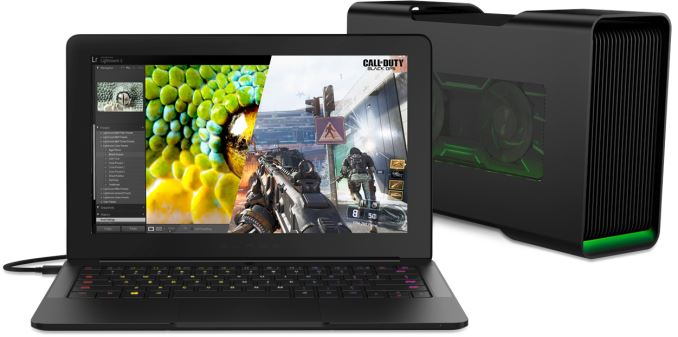
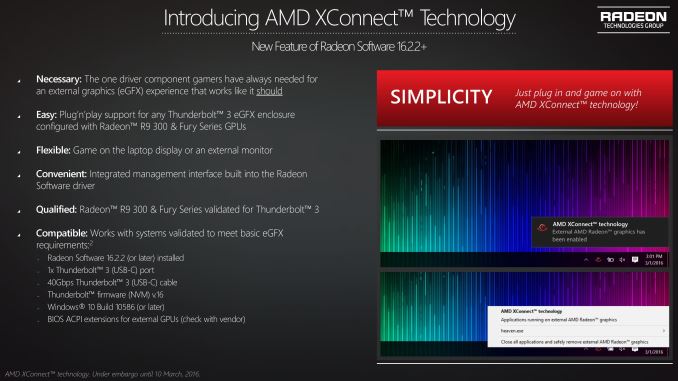
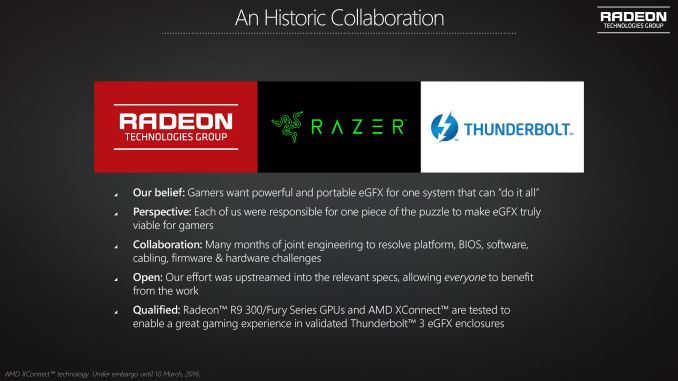
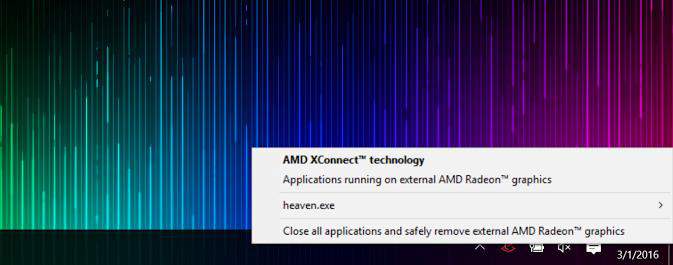

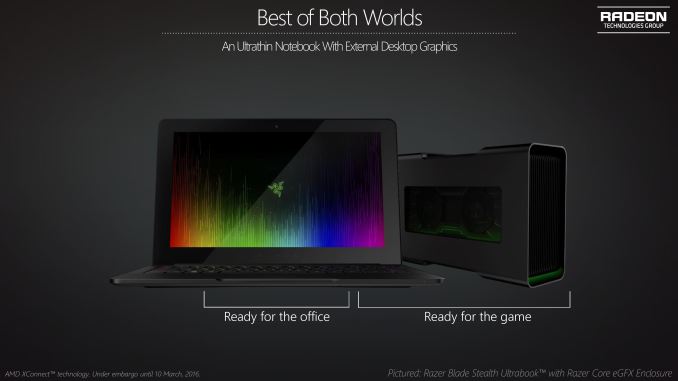














64 Comments
View All Comments
watzupken - Thursday, March 10, 2016 - link
I think the concept is good, but I am not very certain this idea will fly. Price of the chassis is definitely one of the considerations for its success since one probably need to spend extra on a GPU too. And correctly raised, TB connection is not something we find in quite a number of laptops.WinterCharm - Thursday, March 10, 2016 - link
Cheaper than building a separate gaming desktop.protomech - Thursday, March 10, 2016 - link
And more importantly, more convenient.After you've dropped ~$1500 on a high-end ultrabook and ~$500 on a GPU, a few hundred bucks to build a gaming desktop vs a few hundred bucks to buy a TB3 chassis is a bit of a wash.
But being able to use a single system will be a huge win, for some people.
ishould - Friday, March 11, 2016 - link
Typically people will only have to make the initial investment in the high-end ultrabook once, and can upgrade the graphics as needed. Any system with an i7 and 16GB of ram should suffice for a long whilejospoortvliet - Saturday, March 12, 2016 - link
An i7 in an ultrabook isn't exactly in the same league as a desktop i7, but if you're talking midrange it's true that if you start today with a i7 and a midrange gpu you can probably upgrade your way through 2019 or so at least without the cpu becoming the bottleneck.frostyfiredude - Thursday, March 10, 2016 - link
Yeah, it'll be a niche for sure. Costs are going down though and with mainstream support awareness will rise too. Once dedicated boxes can be bought that are tailored to a specific card and essentially plug and play for the customer I think this will have a decent market.andrewaggb - Thursday, March 10, 2016 - link
I'm hoping a vendor will come out with a box with the card built-in. I don't see any reason it needs to be a standalone graphics card in small case. I would think you build something smaller and less expensive if it was a single unit.frostyfiredude - Thursday, March 10, 2016 - link
I feel like its only a matter of time before someone does that, especially with a midrange GPU.dj_aris - Friday, March 11, 2016 - link
Why not even an all-in-one 4K monitor with an embedded beefy GPU which just connects over a single TB cable?rev3rsor - Thursday, March 10, 2016 - link
I think this is something that a lot of people have been looking forward to, so it's good to see a manufacturer actually preparing the eGPU idea as an accessible solution for more people. The way I see it, the target is basically the same as Razer's idea with the Core, but expanding support to all laptops rather than Razer's Stealth (for example, the XPS 13 which is around as good, if not better, than the Stealth in some respects).ULV processors in Ultrabooks may be a bottleneck, but a product category I'd like to see, and that could be feasible now, is 13", 14" or 15" laptops with a strong i5/i7 (maybe even with Iris Pro graphics) and supporting this. This is sort of what I liked about the MSI GS30 (but that came with its flaws), and for those of us who don't need high performance on the go, if it's an affordable package then it could be a good solution for people who need to travel but want to do more intensive tasks at home/work. The way I see it, ultrabooks can be suitable for mobile productivity, while these laptops (probably a more niche market) can make use of higher performance CPUs at the cost of power efficiency, which is improving today anyway. Sort of like the rMBP without the dGPU, but hopefully cheaper.